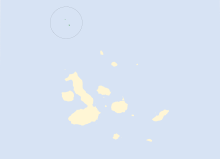Vampire ground finch
| Vampire ground finch | |
|---|---|

| |
| Scientific classification | |
| Domain: | Eukaryota |
| Kingdom: | Animalia |
| Phylum: | Chordata |
| Class: | Aves |
| Order: | Passeriformes |
| Family: | Thraupidae |
| Genus: | Geospiza |
| Species: | G. septentrionalis |
| Binomial name | |
| Geospiza septentrionalis Rothschild & Hartert, 1899 | |

| |
| Synonyms | |
|
Geospiza difficilis septentrionalis | |
The vampire ground finch (Geospiza septentrionalis) is a small bird native to the Galápagos Islands. Endemic to Wolf and Darwin Island, it was previously considered a very distinct subspecies of the sharp-beaked ground finch (Geospiza difficilis),[2][3] but the International Ornithologists' Union has split the species based on strong genetic evidence that they are not closely related, and divergences in morphology and song.[4]
Description
The vampire finch is sexually dimorphic as typical for its genus, with the males being primarily black and the females grey with brown streaks. It has a lilting song on Wolf, a buzzing song on Darwin, and whistling calls on both islands; only on Wolf, a drawn-out, buzzing call is also uttered.[2]
Ecology
This bird is most famous for its unusual diet. When alternative sources are scarce, the vampire finch occasionally feeds by drinking the blood of other birds, chiefly the Nazca and blue-footed boobies, pecking at their skin with their sharp beaks until blood is drawn.[5][6] Curiously, the boobies do not offer much resistance against this. It has been theorized that this behavior evolved from the pecking behavior that the finch used to clean parasites from the plumage of the booby.[7] The finches also feed on eggs, stealing them just after they are laid and rolling them (by pushing with their legs and using their beak as a pivot) into rocks until they break. Finally guano and leftover fish from other predators additionally serve as diet options.[6]
Vampire ground finches drink more blood during dry seasons when seeds and other prey are scarce, resuming omnivorous predation when the rainy season begins. There were also significant variations in the intestinal microbial community structure.[8] There was a clear separation between vampire ground finches and other finches. Vampire ground finch birds have intestinal microbial communities rich in peptostreptococcacea. Similarly, vampire bats also possess peptostreptococcacea in their gut flora.[8]
More conventionally for birds, but still unusual among Geospiza, they also take nectar from Galápagos prickly pear (Opuntia echios var. gigantea) flowers, at least on Wolf Island.[5] The reason for these peculiar feeding habits is the lack of fresh water on these birds' home islands. Nonetheless, the mainstay of their diet is made up from seeds and invertebrates, as in their congeners.[5]
Conservation
The vampire finch is classified as vulnerable by the IUCN based on its very restricted distribution and the impact of invasive species in its habitat.[1]
See also
References
- ^ a b BirdLife International (2022). "Geospiza septentrionalis". IUCN Red List of Threatened Species. 2022: e.T103815245A182414024. doi:10.2305/IUCN.UK.2022-1.RLTS.T103815245A182414024.en. Retrieved 16 May 2024.
- ^ a b Grant, Peter R.; Grant, B. Rosemary & Petren, Kenneth (2000). The allopatric phase of speciation: the sharp-beaked ground finch (Geospiza difficilis) on the Galápagos islands. Biol. J. Linn. Soc. 69(3): 287–317. doi:10.1006/bijl.1999.0382
- ^ Rothschild, W. and E. Hartert. (1899). A Review of the Ornithology of the Galapagos Islands. With Notes on the Webster-Harris Expedition. Novitates Zoologicae Vol. VI, No. 2, pp. 85-205, 2 plates.
- ^ Farrington, Heather; Lawson, Lucinda; Clark, Courtney; Petren, Kenneth (29 July 2014). "The evolutionary history of Darwin's finches: speciation, gene flow, and introgression in a fragmented landscape". Evolution. 68 (10): 2932–2944. doi:10.1111/evo.12484. PMID 24976076. S2CID 205123574.
- ^ a b c Schluter, Dolph & Grant, Peter R. (1984). Ecological Correlates of Morphological Evolution in a Darwin's Finch, Geospiza difficilis. Evolution 38(4): 856-869. doi:10.2307/2408396 (HTML abstract and first page image)
- ^ a b Michel, Alice J.; Ward, Lewis M.; Goffredi, Shana K.; Dawson, Katherine S.; Baldassarre, Daniel T.; Brenner, Alec; Gotanda, Kiyoko M.; McCormack, John E.; Mullin, Sean W. (2018-09-19). "The gut of the finch: uniqueness of the gut microbiome of the Galápagos vampire finch". Microbiome. 6 (1): 167. Bibcode:2018Micb....6..167M. doi:10.1186/s40168-018-0555-8. ISSN 2049-2618. PMC 6146768. PMID 30231937.
- ^ Galef, Bennett G. Jr. (19 August 1990). Bekoff, Marc; Jamieson, Dale (eds.). Interpretation, Intentionality, and Communication. Interpretation and Explanation in the Study of Animal Behavior. Vol. I. Boulder, San Francisco & Oxford: Westview Press. pp. 78. ISBN 978-0-8133-7979-1.
- ^ a b Song, Se Jin; Sander, Jon G.; Baldassarre, Daniel T.; Chaves, Jaime A.; Johnson, Nicholas S.; Piaggio, Antoinette J.; Stuckey, Matthew J.; Nováková, Eva; Metcalf, Jessica L.; Chomel, Bruno B.; Aguilar-Setién, Alvaro; Knight, Rob; McKenzie, Valerie J. (2019). "Is there convergence of gut microbes in blood-feeding vertebrates?". Philosophical Transactions of the Royal Society B. 374 (1777): 374(1777). doi:10.1098/rstb.2018.0249. PMC 6560276. PMID 31154984.
External links
 Media related to Geospiza septentrionalis at Wikimedia Commons
Media related to Geospiza septentrionalis at Wikimedia Commons- "Vampire Finch". Central Pets. Archived from the original on February 10, 2006. Retrieved Dec 19, 2006.

